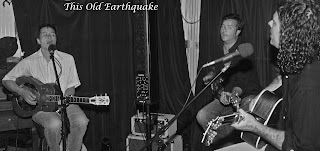Record release partyBolinas Earthquake Ball
by Shari Faye Dell, West Marin Citizen (published December 3, 2009)
Bearing nearly 80 years of musicianship between three members, This Old Earthquakebrings to full gestation the tears, toils and joys of experience with the release of thegroups’ first album, Portuguese Murder Ballads.The self-produced nine-song collection of originals blends sweet harmony and a laid-back tempo into melodies that linger just behind the beat. The effect is somber, bitter-sweet and nostalgically melancholic. The songs invite meditative reflection.In May of this year, the three men–Steve Trivelpiece, Michael Burton and EthanOkamura–made the 3600-mile-round-trip to Palmer Texas for a coveted five-day sessionin Palmyra Studios.
A cut above
“Its one of the nicer analog studios in the country,” say Ethan Okamura, This OldEarthquake’s singing, song-writing guitarist.Owned and operated by Paul Middleton, an engineer to Bonnie Raitt since 1986, Palmyrais home to the audiophile’s collection of state of the art vintage audio equipment as wellas his crown jewel, the 1969 Automated Neve analog-mixing board previously owned byAbbey Road Studios in London.Middleton first heard This Old Earthquake in Bolinas at a private party. “He took someinterest in us,” says guitar and vocal artist Steve Trivelpiece. Later, a mutual friendprovided Middleton with a copy of the promotional CD the group completed inDecember of 2008. From his studio in Texas, Middleton told the Citizen, “I listened tothe songs at least hundreds of times...these songs touched me so strongly I just couldn’tget away from it.”An industry professional for many years, Middleton expresses concern he has withstandard digital recording practices and the tendency to tweak things or over produce, “Ididn’t want that to happen to their music,” he says. “I knew they didn’t need to tamperwith it. All the group needs is find the right feeling and go in there and record,” saysMiddleton. “We wanted to help capture that.” All said and done he adds, “The sheerpassion in the music...it’s one of the best albums I’ve heard in many, many years.”
It takes a village
Being family men, it took the group several months to arrange time off from work andchild-care. Family and friends heartily orchestrated necessities for the journey a van,coolers packed with provisions and domestic support for the young family membersstaying at home.Upon arriving, the group set to the task. “We made the most of it. We slept right in thestudio; we recorded–we were in there [working] 13 or 14 hour days,” says Trivelpiece.
Drawing on experience
The difference between performing before a live audience and recording in a studio is farfrom subtle. While individual instrumental nuances and interpretations may come offnicely during a performance, they don’t necessarily translate into solid musical terms onrecord.“For several years, I’ve been spending a lot of time in the studio,” says Okamura. Inaddition to a former partnership in the Terra Linda studio, Okamura has a studio at home.Thanks to the advancement and availability of technology, “It is easy to stock yourselfwith a descent home studio,” he says.Going into the studio is often a challenge for performers. However, all three of theseasoned musicians have done studio work on other projects. During sessions in TerraLinda for the 2008 demo, This Old Earthquake worked out arrangements and solidifiedparts. The solidarity served them well when they hit Texas–nine songs in five days isquite a feat.“We barely got what we needed to get done;” Okamura iterates, “literally, at three in themorning.” “We were loading the van,” Trivelpiece chimes in. “I was finishing up a guitartrack,” Okamura says with a grin.The group hit the highway for a long haul home at 3:30 a.m..
Fixing an identity
“Wasn’t our first gig at the community center?” asks Trivelpiece, unable to recall theexact moment the ball began rolling.To be certain, in the fall of 2007 Trivelpiece moved back to West Marin following aneleven year-hiatus. Okamura and bass player Miguel Burrtone, (aka. Michael Burton,)expressed an immediate interest in forming an all-acoustic trio. Shortly thereafter, thethree men got together to test the waters. Although the three had played togetherpreviously, more than a decade had passed, they began by picking out a Gram Parsons’tune, Sin City, which was later to become the only obvious inspiration for the groups’official identity. Thus, from the Parsons’ adage, ““This old earthquake’s gonna leave mein the poor house,”” the band name was formed.
Old Earthquake will perform at a semi-formal record releaseparty on Friday, December 4 at the Bolinas Community Center. Serving Hog IslandOysters and wine, the band begins at 8 p.m..
Shari Faye Dell - West Marin Citizen (Dec 3, 2009)
